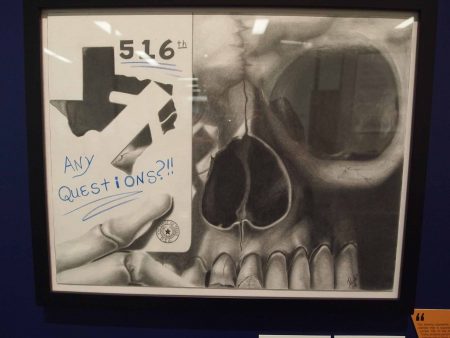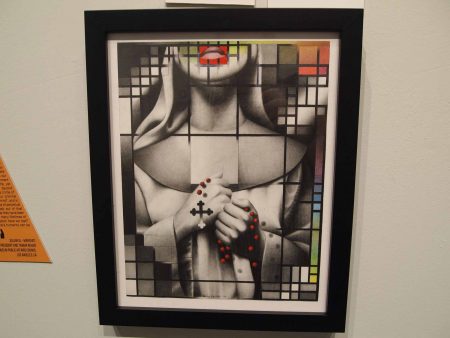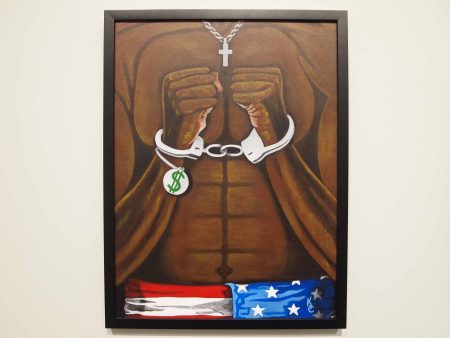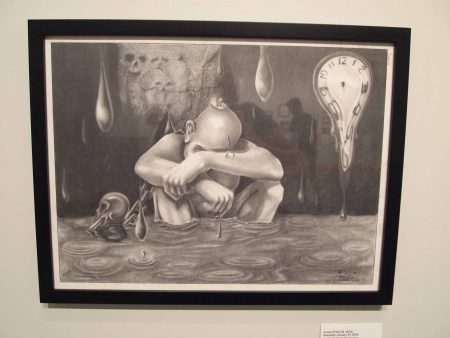
A dialogue: that’s what the gallery attendant at the University of Houston-Downtown O’Kane Gallery told us is the goal of “Windows on Death Row,” an exhibition of inmates’ art and political cartoons that has been touring the U.S. and Europe since October, 2015.
Founded by married couple Patrick Chappatte, an editorial cartoonist for the International New York Times, and Anne-Frédérique Widmann, a television journalist and documentary filmmaker, the exhibition will open at Columbia School of Law, in New York, on September 19, 2017. Most of the artwork can also be viewed at their website.
It really is best to think of it as a dialogue, not an art show—not to downplay the contributors’ skills, especially since they’re creating their art in prison, where resources are scarce. But it’s impossible to remove these pieces from their environment.
As its introduction states: “Images can trigger conversations, sometimes far better than words.” What’s triggered, ultimately, are questions of who deserves our compassion, and how self-expression is indefatigable even in the most inhumane situations—like solitary confinement.


It made me wonder how I would temper my reaction based upon hypothetical people standing with me in the gallery: are they a relative of an inhumanely-treated inmate, or the person he murdered?
Perhaps for this reason, the curators’ intent is clearly stated: instead of focusing on the crime, the exhibit focuses on the inmates’ lives behind bars. Their thoughts, fears, feelings, political beliefs, and the way their humanity is erased.

The exhibition also, however, has a list of short explanations of why each inmate is on death row, with minimal but often harrowing details about their crime. That’s why the route one takes through this exhibition is important.
After the attendant’s introduction, which drew attention to the most technically skilled artist, Arnold Prieto—and how he’d been executed in early 2015—I couldn’t bear to look right at his work. It wasn’t just that he was dead—how many dead artists do we see in museums?—but because it seemed so fresh. It seemed like his drawings, his grasping for survival behind bars, had been ripped from his hands.

Another viewer might have gone straight to his drawings to gain an immediate connection with him. I opted to start with the political cartoons to avoid it. They’re interspersed throughout the pieces, but concentrated in a couple of areas. Many are from the Houston Chronicle. It’s interesting that this is the exhibition’s only stop in Texas so far—a state that is infamous for the number of inmates executed.

Right after enjoying Harold Wayne Nichols’ painting of a starry sky—and his accompanying quote about how you should treasure the stars while you can—I reached the placard listing the men’s crimes. I felt an immediate sense of betrayal to learn that Nichols raped and murdered his niece. (He told the judge, “I want to die,” but his case was automatically appealed.)
But this sense of betrayal is not the goal of the curators. A large amount of literature, and perspectives not only from the inmates but community leaders, focuses on how alarmingly often innocents are sentenced to death. DNA evidence has exonerated prisoners who have been on death row for decades. Most of the artists on display maintain their innocence. One of Chappatte’s cartoons depicts a man being found innocent after 30 years of imprisonment. As he leaves, the establishment says, “He was found poor, black, and guilty… we were only wrong on one count!”

Exoneration doesn’t necessarily equal justice, though. I’ll copy part of the story of Ndume Olatushani, whose painting is one of the most striking and intricate in the exhibition:
“Ndume, 56 years old, spent 28 years in prison, 20 of which on death row, for a crime he did not commit. It took him, his wife Anne-Marie, and his lawyer David Herrington 20 years to set him free. When it appeared that new evidences would be able to prove his innocence, Tennessean judicial authorities offered him an Alford plea: if Ndume renounced to be formally exonerated, he could walk out right away. If not, he would stay in prison during litigation, likely for years. Ndume took the plea. As a result, he’s been a free man since June 2012. But in the books, he is still considered a felon. Ndume lost his right for compensation, he has no right to vote, the jury and prosecutors who wrongfully convicted him will never have to confront their mistakes. And the real perpetrator never faced justice.”
The title of this review is personal, because every review is, whether the reviewer wants to acknowledge it or now. I didn’t like my “reflection” because I left the exhibition feeling guilty about enjoying the art of people who had committed unspeakable crimes. Even if I didn’t feel that way while I looked at the art, that was the detritus that floated to the surface. I’d have preferred to leave riled up for justice, to immediately seek ways to take action against unfair convictions and inhumane treatment. But that would be far too tidy, especially from curator-journalists. Thanks to their work, and the work of partnering organizations, the dialogue continues.